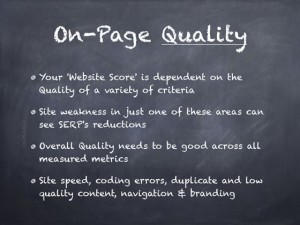SEO Requirements For Top Rankings
April 23, 2014 by admin
Filed under Business, Technology
Introduction to Optimisation
You must understand which algorithm, Penguin or Panda has penalized your website if you are going to fix it. Penguin is the cause if you can see a drop in Google traffic on the 24th April 2012.
You will also notice that the keywords you have used the most in your exact match anchor text are the ones penalized the hardest. We suggest using the free back-link SEO analysis tool at majesticseo.com to see your back-link profile and see which keywords are currently being linked with the most.
Back-Link Profile
Before Google launched Penguin, it was OK to have a link text density of up to 70 percent. This is now dramatically reduced, hence your penalty, you need to reduce the link texts to 5% maximum. Your back-link profile should be dominated by URL links, Brand links and ‘junk status’ links instead of keyword rich text.
Company names or website names are your Brand links that you should use. URL links should be varied instead of using the same URL to link to for all links.
Rather than concentrating on building as many links as possible, it is now more useful than ever to have links from different IP addresses. Aim to get back-links from content related sites.
Look for sites with a good trust score and don’t ask for links on low trust score domains. Where possible try to find pages that will link to you that already have authority back-links pointing to them.
Use of Link Farms
Automated linking networks are never a source of high value back-links. Avoid them no matter what.
Google Panda Requirements
In order to comply with Google’s on-page keyword density requirements, aim for 2%. Add an external link within your page content to an authority .gov or .edu site because Google Panda would like to see external authority links.
Web Content
The only content that you should host on your site ought to be unique, top quality and well written. Google Panda likes to see contextual linking from keywords within your content to other pages of your website, or to authority domain content pages.
Content includes how you present that content. Is your site mobile friendly? If it isn’t, you are missing out on over half of your potential website visitors.
Google have changed to use their mobile algorithm as the primary ranking algo. This means that non mobile friendly sites will not appear in many searches until they make their site responsive for all screen sizes. CRWD are mobile compatibility experts and will soon have you performing in SERPs.
Images and Graphics
Break up any large blocks of text that you have on your pages with suitable images. You can also use videos to increase the time that people spend on your website. You should use alt text behind each image on the page to describe the specific image. Each image should have unique, ‘longtail’ alt text. For more detailed information see www.seo-trainingcourses.com
It is standard practice for Google to evaluate your content and assess its reading age. Google will be able to tell if you are a professor or a child, so always spell check your content and re-read it thoroughly for grammatical errors.
You should always write as much or little as you need to in order to get your message across. That being said, according to Dave Holland, CEO of Deeho SEO, “our evidence is that above 500 words, your content will gain extra weight in search”.
When you are writing new content, write it for the benefit of your visitors, not for SEO and to manipulate search engines. Your readers need to engage with your content as opposed to see optimized text created purely for ranking purposes.
Google can tie related words together using latent semantic indexing (LSI) so that instead of repeating your most important keywords throughout your page content you can include different words that mean the same thing and your content will have a much more natural style.
Meta Data Tags
Unique meta data tags should be on each individual page of your website. You will be penalized in SERP’s if lots of pages have the same metadata. The meta description tag is normally used in search engine results below your page heading. For this reason it is best to write it to obtain a better click through, not for keyword spamming.
User Engagement
Slow websites don’t rank very well. Use YSlow in Firefox to test the load speed of your websites content. Keep your bounce rate under 55% for the best Google rankings. If too many people hit the back button as soon as they arrive on your page then it indicates that your content isn’t ideal for the search traffic that Google is sending you.
Time on Site
Boosting the number of pages that your visitors look at is a good way of boosting the quality score for your website content. Getting your targeted traffic to click through to a second or third page on your site is great for SEO.
You can enhance your Google rankings by improving the average time that visitors spend on your website. Google relates time on-site with content quality and relevance.
If you successfully address all of these areas then you will be well on the way to top Google rankings for your most important keywords and search terms. For more information about improving your SEO see https://www.seo-seo-seo.co.uk and learn everything you need to know and understand to stay in front of the high quality traffic you deserve.

